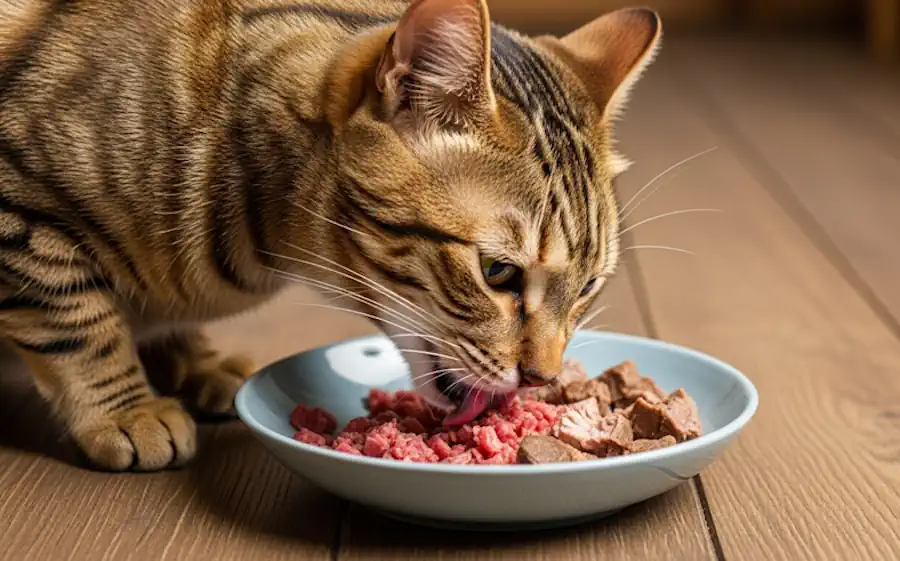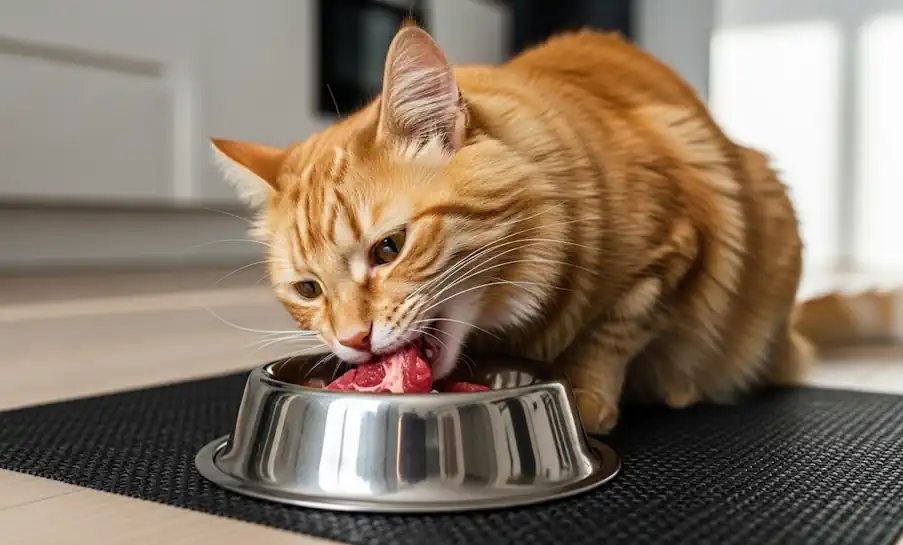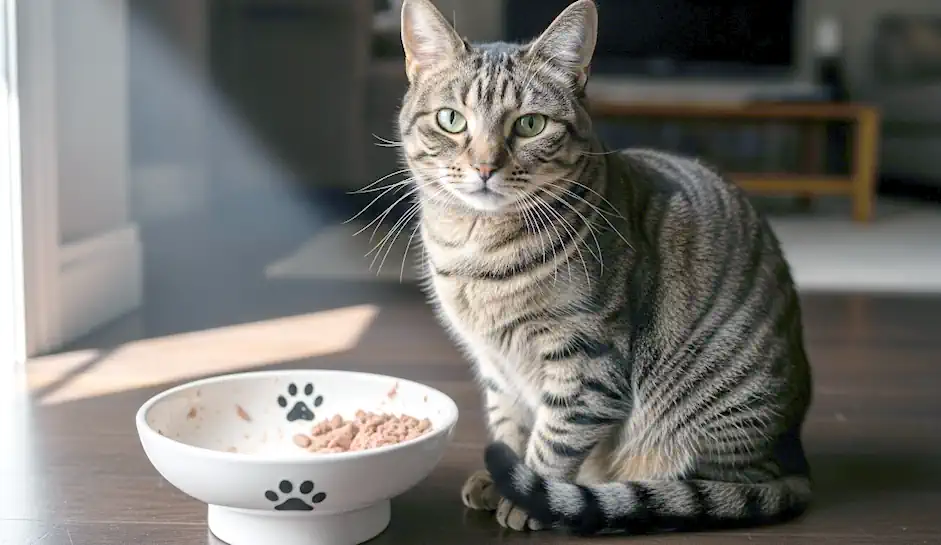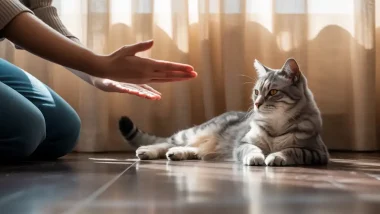Does your cat seem hungry all the time, meowing, begging, or stealing food, even right after eating? You’re not alone. The real reason might surprise you.
Cats don’t need more food. They need better nutrition. When their meals are rich in real animal protein, cats will naturally stop overeating or begging for more. When meals are packed with fillers, no amount of portion control will ever feel satisfying, for you or your cat.

The Real Reason Cats Overeat
Many cat owners assume their pet is greedy, stubborn, or simply has no self-control. But the truth is more straightforward: cats are obligate carnivores. Their bodies run on protein and fat, not on grains or starches. When their food doesn’t provide enough of the right building blocks, their brain keeps telling them to eat.
Think of it this way: your cat isn’t overeating because they want more calories. They’re overeating because their body is still searching for missing nutrients – especially protein and key amino acids like taurine. Until those needs are met, the hunger signal stays switched on.
Why Portion Control Misses the Point
Portion control sounds logical. If your cat is gaining weight, just feed less, right? Unfortunately, that approach rarely works. If the food is low in protein and high in fillers, cutting portions only makes your cat hungrier, louder, and more frustrated. You’re reducing calories without solving the actual nutritional problem.
Some owners try this for months and end up with a miserable cat that still isn’t losing weight. Worse, the cat may start raiding the trash, stealing food, or begging at night. This isn’t bad behavior; it’s the cat’s biology fighting back.
The Protein Solution
Here’s the breakthrough: when cats eat protein-rich meals, their bodies naturally regulate appetite. Getting enough protein tells the brain, “We’re full, we’ve got what we need.” This means your cat is more likely to stop eating on their own, even if there’s still food in the bowl. Less begging. Less stress. Less overeating.

And it doesn’t just affect weight. Adequate protein also supports lean muscle, steady energy, a shiny coat, and even a calmer temperament. Cats fed protein-rich diets often seem more content and less anxious because their bodies and brains are finally running on the right fuel.
How Carbs and Fillers Get in the Way
Most commercial dry foods are loaded with carbohydrates like corn, wheat, peas, rice, or potatoes. These ingredients are cheap, but cats don’t need them. Carbs break down into sugar, which gives a quick burst of energy but no lasting satiety. The cat still hasn’t met its protein target, so the brain keeps pushing for more food.
This is why many cats on dry kibble seem endlessly hungry. They can eat a full bowl and still act like they haven’t eaten. It’s not bad manners – it’s unmet biology.
Simple Signs Your Cat’s Food Isn’t Working
- Begging right after meals
- Raiding other pets’ food bowls
- Constant vocalizing for food
- Weight gain despite “measured” portions
- Hyperactivity followed by energy crashes
If these sound familiar, portion control isn’t the cure. Better nutrition is.
What to Look for in Cat Food
- Protein first: Real animal protein, like chicken, turkey, beef, or fish, should be the main ingredient.
- Moisture matters: Wet, raw, or fresh-prepared foods provide water along with nutrition, just like prey would in the wild.
- Low carbs: The fewer grains, peas, or potatoes, the better.
- Healthy fats: Animal-based fats give lasting energy and support skin, coat, and brain health.

How to Transition Without Stress
Cats don’t like sudden changes. Switching too fast can cause stomach upset or outright food refusal. Instead, make the shift gradually:
- Start with 25% new food and 75% old food for the first week.
- Move to a 50/50 mix in week two.
- By week three, increase to 75% new food.
- By week four, your cat should be comfortable on 100% new food.
During the transition, watch for subtle improvements: less begging, calmer behavior, shinier coat, and more predictable energy levels.
Common Mistakes to Avoid
- Cutting calories without upgrading quality: This just makes your cat hungrier.
- Overusing treats: Many treats are basically sugar bombs. Stick to freeze-dried meat or count treats as part of daily calories.
- Crash dieting: Rapid weight loss can cause serious liver problems in cats. Always aim for gradual, steady results.
- Skipping hydration: A water bowl alone isn’t enough. Food with built-in moisture is key.

A Daily Feeding Framework
If you want a simple starting point, use this framework:
- Feed two to three meals per day.
- Choose wet, raw, or gently cooked foods whenever possible.
- Check the label: protein from real meat should always be first.
- Avoid foods where carbs dominate the ingredient list.
- Adjust portions based on your cat’s body condition, not just the bag’s recommendation.
The Payoff of Protein-First Feeding
When cats finally get the nutrition their bodies are designed for, everything shifts. They stop begging all the time. They eat more calmly. They play with steadier energy. Their weight normalizes without endless battles over food. Their coats shine. Their moods stabilize.
Most importantly, feeding stops being a daily struggle. You don’t have to measure and restrict every gram. You simply provide food that matches your cat’s biology, and their body takes care of the rest.
Flip the Script
If you’ve been stuck in a cycle of portion control, it’s time to flip the script. Don’t feed less, feed better. Choose protein-rich, moisture-rich meals and watch your cat’s appetite, weight, and energy fall into balance naturally.

Note: Always check with your vet before making major diet changes, especially if your cat has a medical condition.

